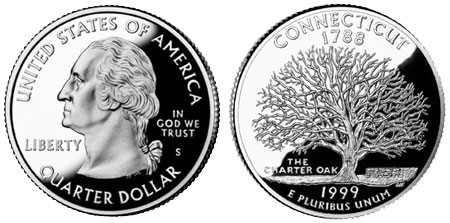Connecticut State Quarters (Buy on eBay) were released on October 12, 1999 as the fifth coin in the State Quarter series. Connecticut’s original Statehood date was January 9, 1788.

The reverse design features the Charter Oak of Connecticut. The inscriptions include the State name, Statehood date, mintage date, “E Pluribus Unum,” and “The Charter Oak.” The coin’s reverse was designed and engraved by T. James Farrell.
When a British representative for King James II challenged Connecticut’s government in 1687, Captain Joseph Wadsworth saved the Connecticut Charter from the hands of the British by hiding it in an oak tree. The famed tree eventually fell during a storm in 1856.
The final design was selected by the Connecticut Commission on the Arts with the governor’s approval after initial review and approval by the United States Treasury Secretary, Citizens Commemorative Coin Advisory Committee, and Fine Arts Commission. The initial design came from a submission to the Connecticut Coin Design Competition. There were 112 Connecticut citizens who submitted design concepts, of that number 19 had depicted the Charter Oak.
The Philadelphia mint produced 688,744,000 coins. The Denver mint produced 657,880,000 coins. These represent the highest State Quarter mintage figures for the year of 1999. The San Francisco Mint produced clad proof and 90% silver proof coins for inclusion in government issued proof sets.
Connecticut Quarter Mintage
- 1999-P Connecticut Quarter: 688,744,000
- 1999-D Connecticut Quarter: 657,880,000
- 1999-S Proof Connecticut Quarter: 3,713,359
- 1999-S Silver Proof Connecticut Quarter: 804,565
Connecticut Quarter Specifications
- Designers: William Cousins after John Flanagan (obverse), T. James Farrell (reverse)
- Composition: 91.67% copper, 8.33% nickel (clad), 90% silver, 10% copper (silver proof)
- Diameter: 24.26 mm
- Weight: 5.67 grams
- Thickness: 1.75 mm
- Edge: Reeded

